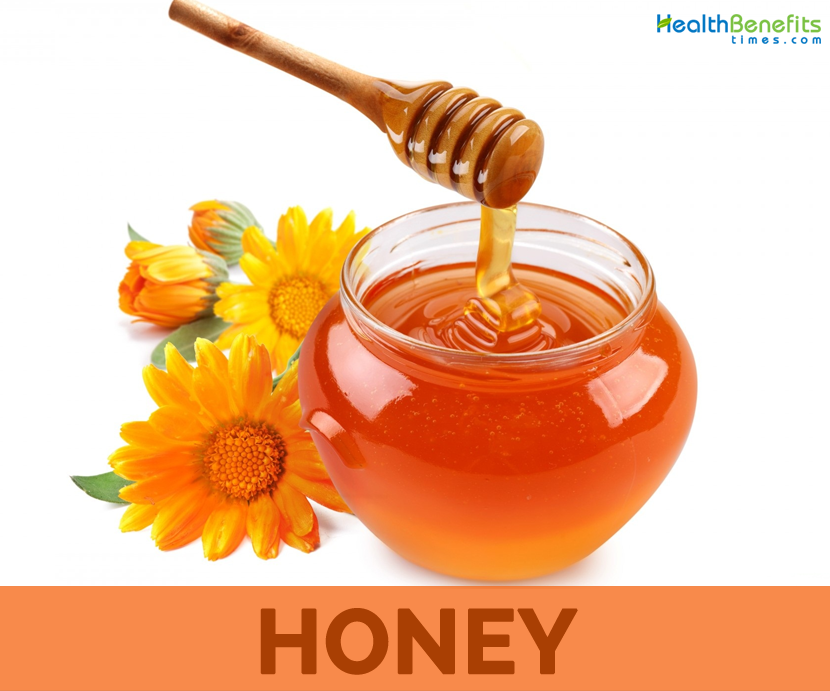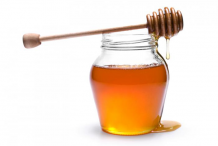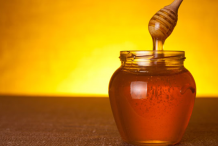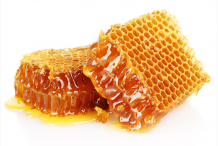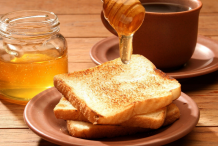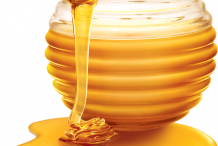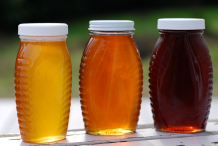Honey is graded by color, with the clear, golden amber honey often at a higher retail price than darker varieties. Honey flavor will vary based on the types of flower from which the nectar was harvested. Both raw and pasteurized forms of honey are available. Raw honey is removed from the hive and bottled directly, and as such will contain trace amounts of yeast, wax and pollen. Consuming local raw honey is believed to help with seasonal allergies due to repeated exposure to the pollen in the area. Pasteurized honey has been heated and processed to remove impurities. Honey is 80% sugars and 20% water. Honey stored in air tight containers never spoils.
Physical properties of natural honey
Honey has several important qualities in addition to composition and taste. Freshly extracted honey is a viscous liquid. Its viscosity depends on large variety of substances and therefore varies with its composition and particularly with its water content. Hygroscopicity is another property of honey and describes the ability of honey to absorb and hold moisture from environment. Normal honey with water content of 18.8% or less will absorb moisture from air of a relative humidity of above 60%. The surface tension of honey varies with the origin of the honey and is probably due to colloidal substances. Together with high viscosity, it is responsible for the foaming characteristics of honey.
The color in liquid honey varies from clear and colorless (like water) to dark amber or black. The various honey colors are basically all shades of yellow and amber. Color varies with botanical origin, age, and storage conditions, but transparency or clarity depends on the amount of suspended particles such as pollen. Less common honey colors are bright yellow (sunflower), reddish undertones (chest nut), grayish (eucalyptus) and greenish (honeydew). Once crystallized, honey turns lighter in color because the glucose crystals are white. Honey crystallization results from the formation of monohydrate glucose crystals, which vary in number, shape, dimension, and quality with the honey composition and storage conditions. The lower the water and the higher the glucose content of honey, the faster the crystallization.
Health benefits of Honey
Honey is a natural product which is widely used for its therapeutic effects. It has been reported to contain nearly 200 substances. Honey is composed mainly of fructose and glucose but also contains fructo-oligosaccharides and many amino acids, vitamins, minerals and enzymes. The composition of honey varies depending on the plants on which the bee feeds. Listed below are few of the health benefits of honey
1. Good for skin
Honey helps to stimulate tissue growth, collagen and new blood vessels in wounds. It can also absorb moisture and keep away microbes. The antibacterial action of honey might be attributable to sugars, low moisture, gluconic acid (which creates an acidic environment), and hydrogen peroxide. Nitric oxide end products in honey might also be useful.
2. Allergies
Ingesting pure honey with traces of pollen may help build a better tolerance to local airborne allergens.
3. Sore throat & cough
Honey is said to calm the throat and ease congestion. A large review concluded that honey is better treatment for acute cough symptoms, and occasionally as good as commercial cough syrups.
4. Gastrointestinal illness
Honey may relieve indigestion and other GI ailments, helping to destroy bad bacteria in the gut. It may also help to protect against gastric ulcers.
5. Workout recovery
Honey appears to act like other forms of rapidly digesting carbohydrates when it comes to athletic performance, recovery and promoting muscle growth. Honey has about the same amount of fructose as high fructose corn syrup and less than agave nectar (different varieties of honey vary slightly in their fructose content).
6. Energy boost
Honey is a wonderful source of unprocessed sugar energy. The glucose and fructose hit the bloodstream quickly, which gives you the boost you need to get moving. It’s a great way to start off a long exercise regimen. Otherwise, include it with your breakfast every morning to give you the boost you need.(1)
Honey contains fructose that helps to metabolize alcohol in the body. Honey contains potassium which is very essential after drinking alcohol. Having 3 to 5 teaspoons of pure honey every 30 minutes can help to relieve from hangover.
8. Memory Booster
As we age, we want to keep our memory sharp, so consuming foods that will give the memory a boost is recommended. Antioxidants are fabulous for feeding the cells of your brain the food it needs to thrive.
As we know that there are plenty of antioxidants in honey, which help to keep our brain in perfect shape. Scientific research shows that honey help postmenopausal women’s memory stay sharp by simply taking one spoonful each day.
Including a teaspoon to a cup of tea each day is an easy and refreshing way to meet that quota. Honey helps the brain absorb calcium, which helps with memory as well. Taking good care of your brain via consuming proper nutrition can decrease your chances of contending with dementia down the road.(2), (3), (4)
9. Helps with Dandruff
Scientific research have discovered that when you apply a diluted solution of honey and water to the scalp and leave it on for a few hours, your scalp will get back to its healthy self in no time.
In fact, some people report that skin cuts completely heal after just a couple weeks of this remedy; others say that they saw an improvement in avoiding hair loss as well. Honey works so well with scalp issues due to its anti-fungal, anti-inflammatory, and antibacterial properties.
Thus feel free to lather up your head with some local honey and receive this deep type of conditioning for the scalp so that you won’t have to worry about dry, flaky scalp any longer. You can even use honey if you don’t have any scalp issues; it will simply moisturize and give your hair a wonderful conditioning.(5), (6)
10. Dental Hygiene
Honey is wonderful for dental hygiene. The use of honey chewing-gum three times a day after meals considerably reduces plaque and the risk of gingivitis. It also has therapeutic properties in the treatment of gingivitis and periodontal disorders. In a study on 10 cases of dental infections, the local use of natural honey in dental abscesses and chronic osteomyelitis proved to have antibacterial effects.
11. Cough Suppressant
Honey is an ancient cough remedy that is loaded with health benefits. Honey coats the throat and keeps it calm by soothing the nerve endings that protect the throat. Some doctors believe that two tablespoons of honey are just as effective as cough suppressants.
World Health Organization (WHO) gives credibility to honey as a demulcent, which helps alleviate a cough due to the honey acting as a protective film over the throat.(7), (8)
12. Can be used as a Moisturizer
Honey is a fantastic ingredient that helps to restore moisture to your hands, feet, and entire body. Since honey retains moisture quite well, you can add it to shampoos, conditioners, and moisturizers for wonderful results.(9)
13. Helps Soothe Acid Reflux
Honey has been known to help prevent Gastroesophageal reflux (GERD) and calm acid reflux and heartburn. Manuka honey from New Zealand is the best type of honey to be used for this, but if you cannot purchase it, any raw, unprocessed honey will do. There is quite a bit of research showing that honey help to reduce symptoms related with acid reflux and it can aid in healing the esophagus.
14. Boosts the Immune System
Frequent consumption of honey can give your immune system a wonderful boost because it has anti-bacterial and antioxidant properties. It can also help cleanse and build up your digestive system, which is essential for optimal health.
15. Helps Prevent and Fight Cancer
Honey consists of wonderful flavonoids and phenolic compounds that make it a super food and give it anti-metastatic properties that can fight tumors and cancer. Honey consists of phenolic compounds like gallic acid, chrysin, elegiac acid, p-Coumaric acid, syringic acid, ferulic acid, and caffeic acid; all are supposed to contribute to the healing of the cells of the body.
The evidence of honey helping with the prevention and healing of cancer cells is growing and much more research needs to be done, but the initial findings are promising. Regular consumption of raw, unprocessed honey can surely be an easy and affordable way to give your body the boost it needs to ward off sickness.(10), (11)
16. Helps with Acne
If you’re struggling with acne, consider adding honey to your diet and applying it to affected areas. It consists of humectants that moisturize your skin and have the ability to kill the bacteria that is causing your acne.
There are several ways you can use honey to help reduce acne. A great way to fight acne is to apply raw, unprocessed honey to the areas on your body that are prone to it; these areas usually being the face, chest, or back. Leave the honey on for about 30 minutes and rinse off with warm water.(12)
17. Increases Sex Drive
Honey is a natural aphrodisiac and regular consumption can give your libido the boost it deserves!
Scientific research says that honey helps men produce more testosterone; as for women, it helps with estrogen levels. It’s been long known that honey can help give people more arousal in the bedroom, yet many are not taking advantage of such an easy remedy for low libido.
Long ago, the Chinese tied a goblet of wine, honey, and a red thread together; those getting married would sip on such to toast to their deep love and union. Hippocrates, the Greek physician, told patients to take honey to increase sex drive.(13)
18. Treats Yeast Infections
Yeast infections are actually quite common but can be a huge problem for women. There are numerous reasons why women get such infections, whether it’s from menstruation, taking antibiotics, sensitivity to soap, bad hygiene, and so on.
Symptoms can range from vaginal itchiness to a white discharge with odor from the vagina. When the acidic nature of the vagina gets out of balance, Candida albicans thrives in such an environment, causing the yeast infection. Now, many women already know that taking Lactobacillus acidophilus helps, but many do not realize that honey may be quite helpful too.
Yes, the flavonoids in honey help keep Candida albicans at bay in a majority of women who try honey as a home remedy. You can mix honey with plain yogurt and use it topically around the vagina area once or twice per day to see if it takes care of the yeast infection.
A good ratio to mix together is 2 tablespoons of raw, unprocessed honey to 1 tablespoon of plain yogurt. If you don’t want to mix it with yogurt, you can simply use raw honey.(14), (15), (16)
19. Helps with Eczema
Honey is a natural treatment that may give you the relief from Eczema. It is actually a skin condition that involved the skin’s outer layer becoming inflamed.
If you’re struggling with eczema, your skin is probably a bit dry and flaky. In fact, some patches may look like little scales.
It is thought that the reason some people get eczema is an overactive immune system and it can be mild, moderate, or severe. For some, it can be an embarrassing condition and can sometimes become painful.
If the skin becomes raw from scratching, a bacterial infection could develop. A wonderful home remedy for such is using a mixture of honey, cinnamon, and lime juice. Just add a teaspoon of honey to a glass of warm water and then add the juice from half a lemon.(17)
20. Helps with Cholesterol
Cholesterol is essential in the body to digest fat, but too much of it isn’t good for the health. Health experts recommend in taking about 1,000 mg of cholesterol per day.
With the body already producing some cholesterol, it’s essential to watch how much meat, eggs, dairy products, and other high-cholesterol foods we consume.(18)
https://www.youtube.com/watch?v=avHzsNqy1oQ
Ayurvedic Health benefits of Honey
- Improve digestion: Use a tablespoon or two to counteract indigestion since it doesn’t ferment in the stomach.
- Relieve nausea: Mix honey with ginger and lemon juice to help counteract nausea.
- Acne cure: It can be used as an affordable face cleanser to fight off acne, gentle on sensitive/all skin types. Take half a teaspoon, warm between hands and spread on face gently, leave on for 10 minutes then rinse with warm water and pat dry.
- Exfoliator: Honey makes a great exfoliator! Use honey on dry winter skin by adding two cups of honey to a bath, soak for 15 minutes, then add one cup of baking soda for the final 15 minutes.
- Improve diabetes: Consumption of raw honey can reduce risk of developing diabetes and help aid medication used to treat diabetes. Raw honey increases insulin and decreases hyperglycemia. Add a little at a time and see how your blood sugar reacts to it.
- Lower cholesterol: It can help reduce cholesterol and thus decrease your risk for coronary artery disease.
- Improve circulation: Raw honey makes your brain function optimally by strengthening the heart and improving blood circulation.
- Antioxidant support: Consumption of raw honey increases plaque-fighting antioxidants.
- Restore Sleep: Raw honey promotes restorative sleep. Add a tablespoon to warm milk to help increase melatonin and help you sleep.
- Pre-biotic support: Raw honey is full of natural prebiotics which promote the growth of good bacteria in the intestine.
- Improve allergies: If sourced locally, raw honey can help reduce seasonal allergies.
- Lose weight: Replacing raw honey for white sugar can help in weight management.
- Moisturize: A spoonful of raw honey mixed with olive oil and a squeeze of lemon can be used as a hydrating lotion.
- Hair mask: Raw honey hair mask can help boost shine, mix 1 tsp of raw honey with 5 cups of warm water, rinse thoroughly, air dry and style as usual.
- Eczema relief: Use to treat mild eczema. Use it as a topical mixture of equal parts of honey and cinnamon.
- Reduce inflammation: Raw honey has anti-inflammatory agents that can treat respiratory conditions such as asthma.
- Heal wounds: Raw honey used topically can help quicken healing time for mild burns, wounds, rashes, and abrasions.
- Cure UTI: Honey can help improve urinary tract infections due to its antibacterial properties.
- Shampoo: Raw honey can cleanse and restore the health of your hair and scalp. Try this homemade shampoo recipe.
- Relieve sore throat: Honey uses for sore throats are another fantastic remedy. Simply mix it with lemon essential oil and peppermint oil for fast acting benefits.
Types of Honey
1. Comb honey
Comb honey is the purest, rawest form of honey. The beeswax is edible.
2. Raw honey
Raw honey often contains wax, pollen, and other bee parts.
3. Liquid honey
Liquid honey is often pasteurized (which decreases the chance of crystallization), and the beeswax has been filtered out.
4. Chunk honey
Chunk honey is liquid honey with chunks of honeycomb.
5. Dry honey
Dry honey is dehydrated, and can be sold as powder, flakes, granules, etc. Usually contains additives.
6. Creamed/whipped honey
Creamed/whipped honey is intentionally crystallized to allow for spreading.
7. Organic honey
Organic honey must be produced without certain pesticides, insecticides, and herbicides. It is hard to control since bees can travel up to 2 miles from the hive to gather nectar and pollen. Only nontoxic paints can be used on the beehives and no medications can be used on the bees.
History
Honey is as old as history is itself. One of the earliest proofs of honey harvesting is on a rock painting dating back 8000 years; this one found in Valencia, Spain shows a honey seeker robbing a wild bee colony. The bees were subdued with smoke and the tree or rocks opened resulting in destruction of the colony.
Archaeologists discovered honey comb in Egypt that had been buried with the pharaohs in their tombs, the honey was preserved and was still eatable. In the Old Testament, the land of Israel was often referred to as the “land flowing of milk and honey”. God nourished Jacob with honey from the rock, and gave Israel fine flour, olive oil and honey. John the Baptist ate locusts and wild honey. Honey is mention in the scrolls of the Orient, the Talmud and Koran.
The Romans used honey to heal their wounds after battles. Hannibal, a great warrior gave his army honey and vinegar as they crossed the Alps on elephants to battle Rome. During the 10 century, the Kings and Queens of England had fermented honey wine (Mead); the Edmeades family produced some of these. Honey has been used for many thousands of years; in fact most man’s history has references to it. Not surprising though, it is an organic natural sugar, has no additives, easy on the stomach, if stored correctly will have an almost indefinite shelf life and easily adapted to cooking processes.
Side Effects of Eating Too Much Honey
Honey has been used by humans for thousands of years as a food and for medicinal reasons. Honey has been recognized for its positive benefits as a food in scientific research since 1892. While it is considered generally safe for healthy adults, just like any other food, there are concerns if you eat too much, in addition to concerns for infants and those with weakened immune systems.
Short-Term Effects
Going over the 10 tbsp. daily upper limit may result in gastric problems such as stomach cramps, bloating and diarrhea. Because of honey’s fructose content, eating too much also might interfere with your small intestines’ ability to absorb nutrients. This can result in further abdominal discomfort until the honey is out of your system.
Long-Term Effects
Constantly over-consuming honey can have long-term negative effects on the gastrointestinal tract. Nutrient absorption could become a permanent problem, even when there is not honey in the system. Honey also is slightly acidic and prolonged exposure to acidic foods can erode tooth enamel and the linings of your esophagus, stomach and intestines, which can lead to acid reflux disease. Excess honey consumption, as with any excess sugar consumption, might result in insulin insensitivity.
Infants
Any honey is too much for an infant. Some honey contains botulism spores, which the immature digestive system of an infant cannot handle, leading to botulism poisoning. The signs of botulism are constipation, weakness, listlessness and decreased appetite. Uncontrolled botulism causes muscle paralysis and eventually death. Because of this risk, pediatricians recommend no honey for children under 12 months or for pregnant or breastfeeding women. Botulism can be treated if detected early and usually leads to a full recovery.
Honey Facts
Honey /ˈhʌni/ is a sugary food substance produced and stored by certain social hymenopteran insects. It is produced from the sugary secretions of plants or insects, such as floral nectar or aphid honeydew, through regurgitation, enzymatic activity, and water evaporation. The variety of honey produced by honey bees (the genus Apis) is the most well-known, due to its worldwide commercial production and human consumption. Honey gets its sweetness from the monosaccharides fructose and glucose, and has about the same relative sweetness as granulated sugar.
| Honey Quick Facts | |
|---|---|
| Name: | Honey |
| Colors | Varies from clear and colorless to dark amber or black |
| Shapes | Thick viscous liquid |
| Taste | Sweet |
| Calories | 64 Kcal./cup |
| Major nutrients | Carbohydrate (13.31%) Iron (1.13%) Fluoride, (1.00%) Copper (0.89%) Manganese (0.74%) |
| Health benefits | Helps with Cholesterol, Helps with Eczema, Treats Yeast Infections, Increases Sex Drive, Helps with Acne, Helps Prevent and Fight Cancer, Boosts the Immune System, Helps Soothe Acid Reflux, Can be used as a Moisturizer, Cough Suppressant, Dental Hygiene, Helps with Dandruff, Memory Booster,Energy boost, Workout recovery, Gastrointestinal illness, Sore throat & cough, Allergies, Good for skin |
| Name | Honey |
|---|---|
| Name in Other Languages | Afrikaans: Heuning Albanian: Mjaltë Arabic: Easal (عسل) Armenian: Meghr (մեղր) Azerbaijani: Bal Basque: Eztia Belarusian: Miod (мёд) Bengali: Madhu (মধু) Bosnian: Med Bulgarian: Med (мед) Catalan: Mel Cebuano: Dugos Chinese: Fēngmì (蜂蜜) Chichewa: Uchi Croatian: Med Czech: Med Danish: Honning Dutch: Honing Esperanto: Mielo Estonian: Mesi Filipino: Pulot Finnish: Hunaja French: Miel Galician: Mel German: Honig Georgian: T’ap’li (თაფლი) Greek: Méli (μέλι) Gujarati: Madha (મધ) Haitian Creole: Siwo myèl Hausa: Zuma Hebrew: דבש Hindi: Madhu (मधु) Hmong: Zib ntab Hungarian: Méz Icelandic: Hunang Igbo: Mmanụ aṅụ Indonesian: Madu Irish: Mil Italian: Miele Japanese: Hachimitsu (蜂蜜) Javanese: Madu Kannada: Jēnu (ಜೇನು) Kazakh: Bal (бал) Khmer: Tukakhmoum (ទឹកឃ្មុំ) Korean: kkul (꿀) Lao: Oa phoeng (້ໍາເຜີ້ງ) Latvian: Medus Latin: Mel Lithuanian: Medus Macedonian: Med (мед) Malayalam: Tēn (തേന്) Malagasy: Tantely Marathi: Madha (मध) Malay: Madu Maltese: Għasel Maori: Te honi Mongolian: Zögiin bal (Зөгийн бал) Myanmar (Burmese): Pyarrrai ko (ပျားရည်ကို) Norwegian: Honning Nepali: Maha (मह) Hebrew: דבש Polish: Kochanie Portuguese: Mel Romanian: Miere Russian: мед Serbian: Dušo (душо) Sesotho: Mahe a linotši Somali: Malab Sinhala: Mī pæṇi (මී පැණි) Slovak: Med Slovenian: Medu Spanish: Cariño Swahili: Asali Swedish: Honung Tajik: Aсал Tamil: Tēṉ (தேன்) Telugu: Tēne (తేనె) Thai: N̂ảp̄hụ̂ng (น้ำผึ้ง) Turkish: Bal Ukrainian: мед Urdu: شہد Uzbek: Asal Vietnamese: Mật ong Welsh: Mêl Yoruba: Oyin Yiddish: Honik (האָניק) Zulu: Honey |
| Honey Consistency | Thick viscous liquid |
| Honey Color | Varies from clear and colorless to dark amber or black |
| Taste | Sweet |
| Varieties |
|
| Major Nutrition | Carbohydrate 17.3 g )(13.31%) Iron, Fe 0.09 mg (1.13%) Fluoride, F 1.5 µg (1.00%) Copper, Cu 0.008 mg (0.89%) Manganese, Mn 0.017 mg (0.74%) Vitamin B2 (Riboflavin) 0.008 mg (0.62%) Zinc, Zn 0.05 mg (0.45%) Vitamin B6 (Pyridoxine) 0.005 mg (0.38%) Selenium, Se 0.2 µg (0.36%) Vitamin B5 (Pantothenic acid) 0.014 mg (0.28%) Potassium, K 11 mg (0.23%) |
| Health benefits |
|
| Calories in 1 tbsp (21 gm) | 64 K cal |
| Culinary uses |
|
| Other Facts |
|
| Precautions |
|
References:
https://www.ncbi.nlm.nih.gov/pmc/articles/PMC3758027/
http://www.ejmanager.com/mnstemps/165/165-1482821246.pdf
http://www.id-press.eu/oldmjms/article/download/586/754


